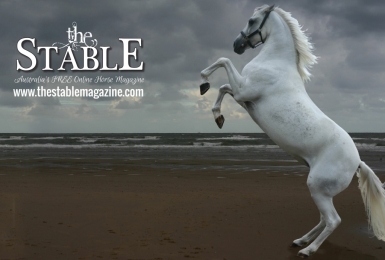Stallionzone News
Is Stallion Ownership For You?
Extracted from the September 2013 issue of The Stable Magazine – www.thestablemagazine.com/september2013
 What is involved with owning and handling a stallion? We take a look at whether owning a stallion is an option for you...
What is involved with owning and handling a stallion? We take a look at whether owning a stallion is an option for you...
Some trainers insist that stallions make the best students. No doubt, they have a flair and exciting aura surrounding them. They are quick to learn, highly trainable and the sight of a majestic stallion galloping across the paddock easily captures the imaginations of horse lovers everywhere. This, however, does not mean that a stallion is a suitable choice for the majority.
Owning a stallion isn’t practical for most riders. Not only can they be unpredictable, but they also require good, safe, solid fencing, and often, the life of a valuable stallion means a life of solitude. Breeding stallions on large studs may only leave their paddocks to do their job. When time is a luxury for all stud hands, stallions learn their routine, and consequently leaving the paddock is cause for great excitement - and excitable behaviour.
That’s not to say that this is the case for all breeding stallions. Many compete successfully and are able to maintain a successful career in their chosen discipline as well as sire foals. Much of this comes down to handling, time, and discipline.
Studies have also been undertaken to establish the risks and benefits of housing stallions together, with promising results. The risks in this are obvious - in that stallions may show aggression towards one another beyond that of establishing a herd hierarchy. One study of a cross section of stallions found that aggression between the horses gradually declined after a period, where previously it was thought that it was much too dangerous to house stallions together - both for the risk of injury and the possible financial loss should it render a stallion unable to continue his stud duties.
If you have a colt and are thinking of leaving him entire - ask yourself the following questions.
Are you geared up for handling a stallion?
They are not always predictable, and may prove to be more than a handful!
Do you have the time to invest?
Stallions require regular handling, and just like every other horse, require mental stimulation. If the stallion is housed by himself, it will fall on you to provide this. Unstimulated horses easily develop vices - fence walking, weaving, crib biting, windsucking - and others that
Have you enough experience?
If you're nervous when horses are flighty, hot-headed, or if you aren’t capable of reading a horse’s body language well, a stallion is not for you. Discipline is also a key factor in handling all horses. Stallions may push the boundaries - and it’s important that you’re able to let the horse know just where the boundaries are, and ensure he doesn’t cross them.
Do you have the facilities?
Stallions require good solid, safe, fencing.
Is your stallion worth keeping entire?
Even if he’s a colt out of your favourite mare, this doesn’t warrant keeping him entire. Stallions are left entire to pass on genetic information, talents, characteristics, etc to their progeny. If there’s nothing worth passing on, the horse should be gelded. Part of this also comes down to temperament. While stallions may be hot, excitable and flighty, this does not make an unfavourable horse. Top performance horses may be flighty, hot of temperament and bold - on the ground they may be quiet - under saddle, it might be a completely different story. To be successful in a discipline, a horse should be bred for the characteristics required. It’s a bit of a case of ‘horses for courses’! Above all, a stallion should have desirable qualities. While there’s no such thing as the ‘perfect’ horse, the good qualities and suitability of the horse for it’s chosen discipline should outweigh the horse’s downsides. Mares should be carefully chosen according to the stallion to ensure that the resulting foals are as close to perfect as possible.
HANDLING STALLIONS
Handing stallions begins with handling colts, and a good solid foundation to a well-mannered stallion is to set the boundaries from an early age. The same goes for handling all foals. Spoiling horses can happen very quickly. Encouraging or not putting a stop to bad behaviour when horses are young can exacerbate the problems. Playful rearing, nipping, and cheeky behaviour might seem cute in a three month old foal, but if no discipline is exercised, that same behaviour from a full grown horse (particularly a full grown stallion) can prove very harmful. Much of this comes down to the respect of the horse for the handler.
If a stallion has a bad reputation, it may not be the horse’s fault. Handling (whether good or bad) has much to do with this. Stallion handlers should be alert, experienced, level headed and confident enough to handle their stallions in all situations. All handing (again, good handling or bad handling) shapes the horse’s attitude and reactions.
Stallions who are run with other horses and handled well from a young age are more well-socialised. In a herd hierarchy as a youngster, the colt learns his place in the herd, and the consequences of any wrong-doing. Take this learning away, isolate a stallion who is full of hormones, and you might run into trouble. If you think about the situation from the stallion’s point of view - his job is to fight other stallions for dominance, in order to cover mares. Stallions may view their handlers as a rival - or in some cases, preventing the stallion from doing what instinct tells him to.
If your horse is unruly (stallion, mare OR gelding) the ‘fight’ that you have with them should never escalate into a physical one. There’s no way that a handler has the brawn to ‘out muscle’ the horse. Instead, you must demand his or her respect, insist on good manners, and he must learn that you won’t tolerate bad behaviour. Physically punishing a horse for nipping will either create fear or loathing - neither of which is productive. Showing the horse that he doesn’t get his own way through aggressive behaviours or using methods that do not reward the horse for his behaviour (preventative measures) are often the best solution. For example, if you’re leading your horse and he turns to nip at you, carry a metal curry comb or similar tool. When the horse turns his head to bite, he will knock his nose on the metal curry comb. No aggression involved, but the horse has learned that there was no positive connection to his actions. Eventually, the behaviour will cease. Obviously, safety of both horse and handler is paramount, so if you are ever in the situation with a horse or stallion that may be dangerous, minimise risk, don’t be overconfident, and seek the help of a more experienced rider or handler if in doubt. Don’t ever put yourself at risk.
This article was originally published in the September 2013 issue of The Stable Magazine – Australia’s FREE Online Horse Magazine. Read this article and many more online at www.thestablemagazine.com
Categories
- General
- Event Results
- Stallionzone
- Sponsored Shows
- Clubs
- Health
- Feature Horses
- Competitions
- Five Minutes With Horsezone
- Young Riders
- Reviews
- Training and Clinics
- Postcards from the saddle
- 2014 Equitana by HORSE FIRST
- 2013 Equitana
- 2012 Equitana
- 2012 London
- 2011 Equitana
- 2011 Queensland Floods
- 2010 WEG

